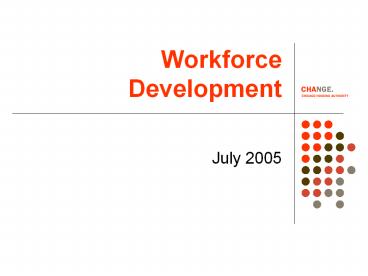Workforce Development - PowerPoint PPT Presentation
Title:
Workforce Development
Description:
Workforce Development July 2005 Context The Plan for Transformation Redevelopment of isolated housing structures into integrated neighborhoods Re-integration of the ... – PowerPoint PPT presentation
Number of Views:254
Avg rating:3.0/5.0
Title: Workforce Development
1
Workforce Development
- July 2005
2
Context
- The Plan for Transformation
- Redevelopment of isolated housing structures into
integrated neighborhoods - Re-integration of the population into the fabric
of the city
3
Partners
4
Families with OpportunitiesTotal number of
households 12,606
5
The Goal for Families
- Achieving self-sufficiency
- This means families will have income and benefits
sufficient to reduce their dependency on public
housing and other government subsidies.
6
Results for Families
- Families are stable
- Traditional case management work links to
education, child care, mental health, medical and
substance abuse treatment, etc. - Families have more household income
- Measures increases in the array of assets coming
into a home, including employment, work supports,
etc - Families have more housing choices
- Includes lease compliance, household budgeting,
housing quality standards, etc. - Families are involved in their communities
- Focuses on families becoming more connection to
local churches, block clubs, and other
neighborhood activities.
7
Tracking Our Success
- Participation rates
- Employment Placements
- Service Referrals
- Status during Move-In
- Customer Satisfaction
- Data exchanges with The Chicago Public Schools
and the Illinois Dept. of Employment Security
8
Workforce Development
- Education and Job Training for individuals who
are motivated to work - Employers who are prepared to make civic
commitments to the Plan for Transformation - A Quality Match between an employers needs and a
residents interests - Support over time for retention and career
trajectories
9
Lessons Learned
10
Education Levels Among Adults
Education Levels among 2004 Service Connector
Clients, Source Service Connector
11
Literacy Among Adults
12
Children in CHA Households
- 59 of households have children living in them
- On average, those households have three children
in them (2.7). - 15 of households have four or more children.
13
CHA Elementary School ChildrenRates of Failure
on Basic Reading Tests
14
CHA Youth in Public Schools
15
Barriers to employment
- Literacy low levels among residents are a
profound barrier to employment - Skills Entry level positions in the global
economy often require a skills set that exceeds
that of many residents - Work History a critical mass of residents have
little or no work history - Motivation years of isolation in under-employed
communities had a negative impact on motivation
to work
16
Individualized Approach
- Leveraging the whole population vs. a tiered
approach to current needs - Employment trajectories for those who are
employed - Consistent employment for those who are
sporadically employed - Employment skills for those with little or no
work history - Inventory of interest level in job opportunities
based on market availability
17
Support skills and life experience
- Soft interview and job preparation
- Resume writing
- Interview skills
- Acceptable attire
- Professional behavior
- Retention Support
- Early warning systems for newly employees
- Regular follow up with newly employed residents
18
Remaining Questions































